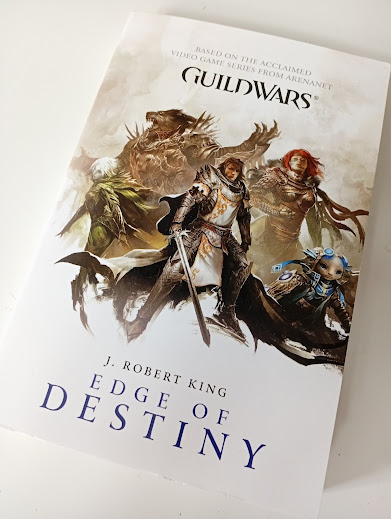Book Review: Guild Wars: Edge of Destiny
Guild Wars: Edge of Destiny by J. Robert King is a novel set in the universe of Guild Wars 2, serving as a prequel to the events of the game. The book focuses on the formation of Destiny’s Edge—a diverse group of heroes from various races of Tyria who unite to face the deadly threat of the Elder Dragons. While the novel has its strengths—especially for fans of the franchise—it suffers from several flaws that impact its overall quality.
Strengths: The World, Characters, and Fan Service
For Guild Wars 2 players, this book is a treasure trove of lore and behind-the-scenes insight. We witness the origins of the conflicts within Destiny’s Edge, their motivations, and key moments that shaped future events in the game. The first part of the novel is particularly strong, introducing individual storylines of the human mercenary Logan Thackeray, the charr warrior Rytlock Brimstone, the norn huntress Eir Stegalkin, and the asuran inventors Snaff and Zojja. The dialogue is often humorous, and the chemistry between the characters is genuinely engaging.
The cast is diverse, and each character brings something fresh to the team:
Logan begins as a soldier of fortune but gradually transforms into a knight loyal to Queen Jennah. His moral dilemmas are among the book’s more compelling aspects.Eir and Garm (her loyal wolf) combine strength with tragedy, as Eir feels a deep need to atone for the mistakes of her ancestors.
Snaff and Zojja serve as comic relief, but their technological genius adds a sci-fi edge to the otherwise fantasy setting.
Rytlock is a gruff but loyal charr warrior, whose tense relationship with Logan is one of the novel’s better-written threads.
Caithe, the enigmatic sylvari, remains somewhat underdeveloped—her presence is intriguing but ultimately underused.
Weaknesses: Uneven Writing, Shallow Fights, and Pacing Issues
Unfortunately, once the team comes together, the book loses its initial momentum. The narrative becomes formulaic: the group faces enemy after enemy, with battles that feel rushed and lacking in suspense. Despite facing powerful dragon minions, most confrontations are resolved too easily, leaving the reader with little sense of real danger.
The biggest issue is the inconsistent writing style. While the first half is vibrant, humorous, and full of personality, the second half feels mechanical—almost as if the author was simply filling in a game studio–provided outline. The final chapters, though epic in scale and important to the Guild Wars 2 lore, are drawn out and lack the emotional weight of earlier scenes.
There are also several lore decisions that may frustrate dedicated fans:
The sylvari lore is less developed here than in Ghosts of Ascalon, despite this book being released later.Faolain appears abruptly with no introduction, potentially confusing readers unfamiliar with the game.
Rytlock, rather than being a fierce warrior, is often reduced to comic relief, which clashes with his portrayal in the game.
Who Is This Book For?
Fans of Guild Wars 2 – This book offers essential context to the game, explaining why Destiny’s Edge broke up and how Kralkatorrik changed the face of Tyria.Fans of light, fast-paced fantasy – If you don’t mind a cartoonish style and predictable fights, you may find it enjoyable.
Not for those seeking depth – If you expect refined character development or gripping tactical battles, you’ll likely be disappointed.
Conclusion: 6/10 – Fun, But Only for the Initiated
Edge of Destiny works best as a companion to Guild Wars 2, enriching the lore and offering background for familiar faces. On its own, however, it’s not an outstanding piece of fantasy fiction. The first half entertains, the second half drags, and the finale—while significant to the world—isn’t enough to overcome the overall mechanical feel. If you’re a series fan, it’s worth reading for context. If not, you’re better off looking elsewhere.


















No comments